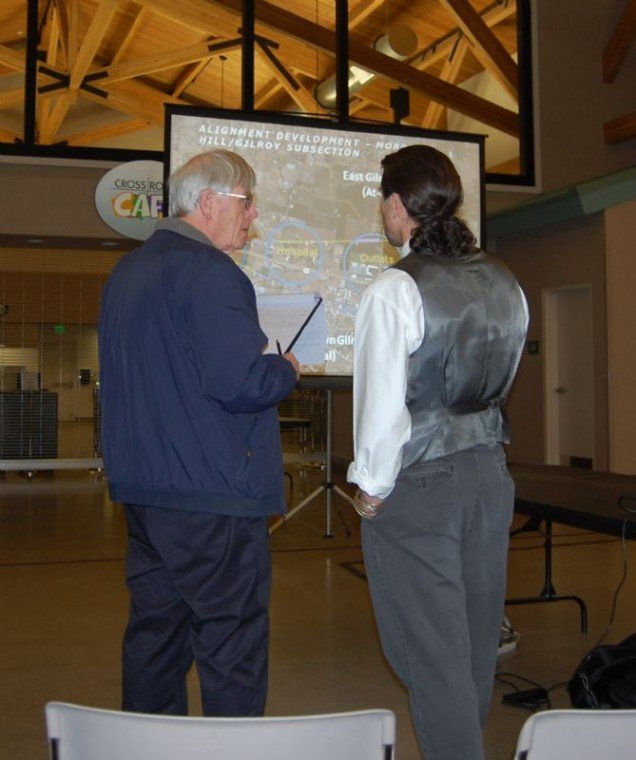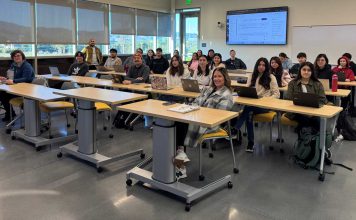Residents who attended a California High-Speed Rail Authority
community meeting Tuesday night at Gilroy High School made one
message clear: Don’t build a rail station east of Gilroy.
Gilroy Mayor Al Pinheiro and City Councilman Perry Woodward took a hard stance Tuesday morning while meeting with Roelof van Ark, CEO with the California High-Speed Rail Authority.
If the CHSRA wants to build a station in Downtown Gilroy, tracks will have to be trenched, they said. If not, the station must go east of town.
On Tuesday night, residents made their own demands.
The majority of comments submitted by roughly 60 residents who attended a CHSRA outreach meeting at Gilroy High School offered one clear message: Don’t build the station east of town where valuable agricultural land exists.
Gilroy City Councilman Dion Bracco said he sensed “a lot of anger” from residents regarding the high-speed rail projects.
“It’s changing their way of life,” he said. “How do you plan for retirement if this thing might come through your home in 10 years?”
Preliminary plans for a high-speed rail station in Gilroy not only call for a station built either downtown or east of town, but early alignment designs show agricultural land in South Santa Clara County will be negatively affected regardless of which route the rail ultimately takes.
“No matter which way the high-speed rail goes, it will cut through farmland,” said Jennifer Williams, executive director for the Santa Clara County Farm Bureau. “You can’t pick up and move farmland. Once it’s gone, it’s gone,”
CHSRA Regional Manager Gary Kennerley said the high-speed rail’s draft environmental impact report, which he said can be shaped by public comments at meetings such as the ones held in Gilroy and Morgan Hill, would be completed either in August or September of this year.
After that, residents will be allowed to read the draft EIR and submit comments until spring 2012. The CHSRA board is not expected to select a final rail alignment until late spring or early summer 2012. Construction would being in 2013, according to the CHSRA.
“The EIR will contain all the analysis,” Kennerley said. “What are the tradeoffs? Where should we go with it?”
He added, “This is a work in progress.”
Mike Kennedy, whose wife Sherrie owns Sherrie’s Farm east of Gilroy, said he wasn’t sure just how the high-speed rail would affect the farm and the surrounding area.
“We really don’t know yet,” he said. “We really haven’t seen enough detailed drawings to know.”
Kennedy said current drawings show the project’s alignment clipping the east/northeast corner of the Sherrie Farm’s property. He said the project could take out the farm’s agricultural well and create dust and noise issues.
“It’s premature to really understand all the impacts,” Kennedy said. “We just have to sit and wait.”
That’s been a problem for farmers in the county and statewide, Williams said.
“We have a lot of questions we’ve been asking for months. We’ve received no answers,” she said.
Williams attended the CHSRA’s public outreach meeting Tuesday night at Gilroy High School, but she said project engineers on hand weren’t qualified enough to answer questions relating to imminent domain.
“We can’t have this level of uncertainty this deep into the process,” she said.
Sen Luan, who bought his property near Frazier Lake and Holsclsaw roads more than a year ago, said preliminary plans for at-grade design east of town require a rail maintenance station to be constructed almost on top of his home.
“I don’t know yet what I can do,” Luan said.
The drawings could be changed to accommodate residents’ needs if possible, said rail engineer Peter Chu.
“This is preliminary,” Chu said. “It’ll be completely different tomorrow. People have been living here a long time. Feedback we get from citizens can be used to tweak our designs so there are fewer impacts.”
A second CHSRA community outreach meeting was held Thursday night at the Hiram Morgan Hill Room, with future plans of a San Martin meeting, according to Woodward.
As for Van Ark, when he visited Gilroy in December, he told city officials what to expect from the state’s $45-billion, 800-mile project set for operation in 2020.
On Tuesday, it was his turn to listen as members of a Gilroy-Morgan Hill task force met with the CEO for a little more than two hours as the two sides continued to discuss the best ways to bring a bullet train through the city.
The task force, which is comprised of Pinheiro, Woodward, City Administrator Thomas Haglund and Morgan Hill representatives Mayor Steve Tate and City Manager Ed Tewes also discussed parking and funding issues. Haglund said the point of the meeting was to build trust through face-to-face discussions.
Regarding the at-grade design – which would call for the construction of traffic overpasses – Woodward said, “I think that’s over.”
Woodward said he and Pinheiro did make one thing clear to Van Ark: If the train is going to roll through Downtown Gilroy, the tracks will have to be laid in a trench design.
Pinheiro said they did not discuss whether the city would have to pay for trenching costs.
“We didn’t go to that level,” he said.
Bracco said more in the community have been speaking out against the project after learning how it may impact Gilroy and other parts of South County.
“I think (CHSRA officials) are finally working with the people,” he said. “They can’t go in with the attitude that they are just going to push it through.”














